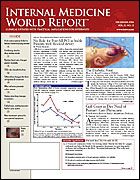New Studies of Drug-Eluting Stents Show No Consensus
From the American Heart Association
CHICAGO—A series of conflicting reports at the American Heart Association (AHA) meeting offers no clarity with respect to the safety of drug-eluting stents versus bare-metal stents, a controversy that has been brewing since new data from 2 meta-analyses were presented at the World Congress of Cardiology (WCC) in Barcelona this past September.
Some studies presented at the AHA meeting show an increase in major adverse coronary events over the long-term with drug-eluting stents, whereas others show no difference in event rates, and others still show not only a decline in the subsequent need for coronary artery bypass graft (CABG) surgery and repeat percutaneous coronary intervention, but also fewer adverse clinical events.
In a registry of 9043 patients undergoing intracoronary stenting at Intermountain Healthcare’s LDS Hospital/ University of Utah, the rates of major adverse coronary events (death, nonfatal myocardial infarction [MI], target-vessel revascularization, or CABG) were assessed out to 3 years for patients receiving either bare-metal or drug-eluting stents. “After the first year, there were statistically worse outcomes with drug-eluting stents versus bare-metal stents,” said coauthor Joseph B. Muhlestein, MD, of the University of Utah, Salt Lake City.
P
P
By 3 years, the risk of major coronary events was increased by 36% ( <.001), and all-cause death was 93% more likely (<.001) with drug-eluting stents, he said. Although the drug-eluting stents reduced the rate of target-lesion revascularization, revascularization not related to target-vessel lesion was more common with the drug-eluting stents, which resulted in a significant increase in all forms of coronary revascularization at 3 years.
The drug-eluting stents may have contributed to an acceleration of atherosclerosis in nonstented coronary segments, Dr Muhlestein said, a contention supported by studies that show evidence of endothelial dysfunction in coronary segments distal to the drug-eluting stent.
A National Heart, Lung, and Blood Institute (NHLBI) registry of 3223 patients who received either a bare-metal stent (October 2001 to March 2002) or a drug-eluting stent (February to May 2004) produced quite different findings.
In the NHLBI registry, there was no difference in the rate of death or MI between the 2 groups, and the need for CABG was significantly less with the drug-eluting stent compared with the bare-metal stent (1.2% vs 3.1%; P <.001). Target-vessel revascularization, repeat revascularization, and major coronary events were all significantly less likely in the drug-eluting stent group, said David O. Williams, MD, director of Cardiovascular Laboratory and Interventional Cardiology, Rhode Island Hospital, Providence.
He noted that the drug-eluting stents performed as well as the bare-metal stents, despite a mix of more complex lesions treated in the patients who received the drug-eluting stents, as well as a greater cardiovascular risk factor burden in this group.
Sidney Smith, MD, of the University of North Carolina, Chapel Hill, commented that meta-analyses presented at the WCC meeting showed late stent thrombosis to be a problem with drug-eluting stents, which may not have been reflected in the NHLBI’s registry at 1 year.
A randomized study of 216 patients who had either a paclitaxel (Taxol) or sirolimus (Rapamune)-eluting stent or a bare-metal stent implanted for ST-segment elevation MI found a strong trend toward better outcomes with the drug-eluting stents compared with the bare-metal stent at 18 months.
In this study, conducted at University Hospital Basel in Switzerland, the rate of major adverse coronary events was higher in the bare-metal stent group (20.3%) than in the groups assigned to the drug-eluting stents (13.4%) but did not quite achieve statistical significance. The 2 drug-eluting stents performed similarly in this study.
Another study of 505 patients undergoing primary angioplasty and treated with either bare-metal or drug-eluting stents found an early advantage for drug-eluting stents with respect to target-vessel revascularization. However, drug-eluting stents (either the sirolimus-eluting or the paclitaxel-eluting stent) were no longer significantly superior to bare-metal stents after 3 years of follow-up in reducing major adverse coronary events, said lead investigator Joost Daemen, MD, of the Thoraxcenter, Erasmus Medical Center, Rotterdam, the Netherlands. Mortality was comparable between the bare-metal and drug-eluting stents at 3 years.
“Fifty percent of target-vessel revascularizations were performed after the first year of follow-up due to stent thrombosis, and 100% of the MIs after the first year were due to stent thrombosis,” he said.
Key points
• The verdict is still out concerning the safety of drug-eluting stents versus bare-metal stents.
• A 3-year study reported worse outcomes with drug-eluting stents compared with baremetal stents.
• Other studies, however, reported favorable results for the drugeluting stents.
• This controversial issue is far from over, as experts continue to debate which stent to use in patients requiring coronary intervention.
